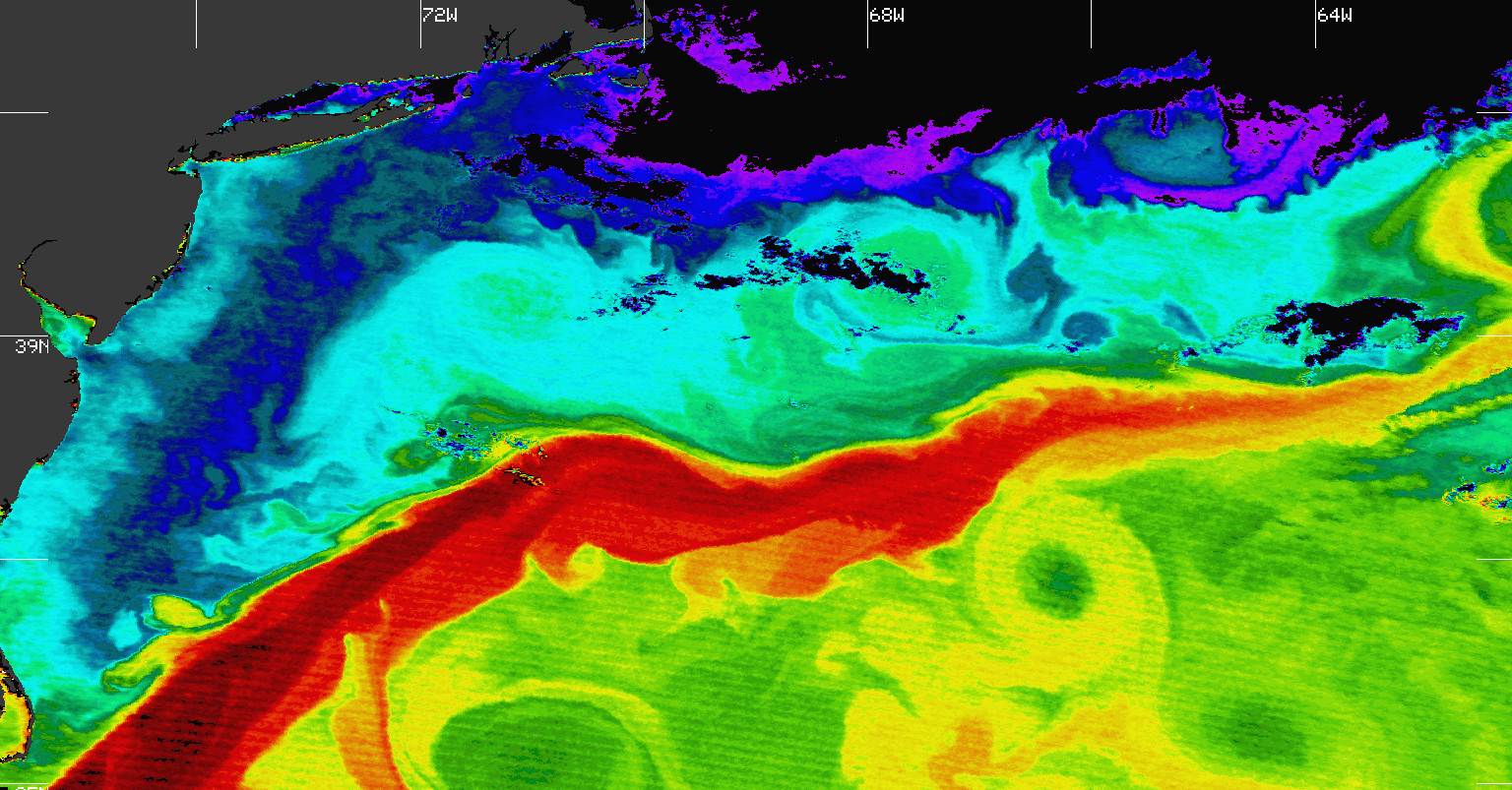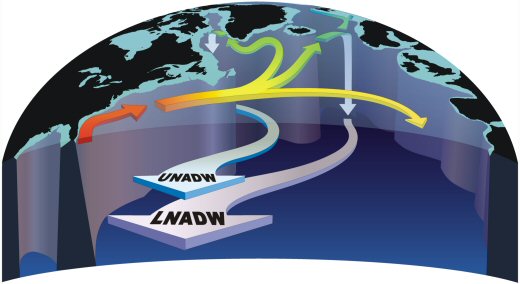Title image: the Gulf Stream (NASA)
Will the AMOC Collapse?
Ocean currents received a lot of press coverage the last few months, after a few new scientific studies published their results. Social media was rife with lighthearted comments that the movie The Day After Tomorrow was starting to resemble a documentary.
So what’s really going on? And why are ocean currents a climate issue? Let’s find out and take a deep dive (sorry) into ocean circulation and its links to climate.
Global Ocean Circulation
Wind-driven currents and gravity-driven tides are visible and familiar elements of ocean circulation. But there is a less visible global element of ocean circulation, driven by density differences within the ocean, called the thermohaline circulation, or THC. The density of sea water is affected by temperature and salinity, hence the thermo+haline name. (Warm water is less dense than cold water. Salt water is more dense than freshwater.) The thermohaline circulation is powered by inputs of heat and freshwater across the ocean surface, and the deeper mixing of heat and salt that results. Precipitation, runoff from land masses, and melting ice input freshwater, decreasing salinity, while evaporation and sea ice formation increase salinity.
The THC is the driving mechanism behind a massive and continuous overturning of the global ocean, from top to bottom. The figure below shows how and where that overturning occurs.
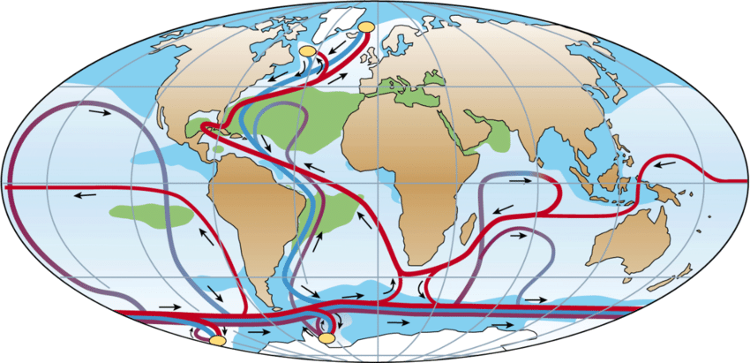

A representational diagram of the global Thermohaline Circulation. Surface currents in red, deep waters in mid-blue and bottom waters in dark blue. Credit: Stefan Rahmstorf/Potsdam Institute for Climate Impact Research
The components of the thermohaline circulation are:
- Deep water formation – sinking of dense water masses. Found in a few locations: the Greenland-Norwegian Sea, the Labrador Sea, the Mediterranean Sea in the Northern Hemisphere, and the Weddell Sea and Ross Sea in the Southern Hemisphere.
- Distribution of deep waters, primarily as deep currents
- Upwelling of deep waters, mainly in the region of the Antarctic Circumpolar Current and aided by wind
- Near-surface currents – the upper level currents that compensate for the outflow of deep waters, In the Atlantic the outflow of North Atlantic Deep Water from the subarctic southward is compensated by northward flow from the Benguela Current off South Africa, via the Gulf Stream and the North Atlantic Drift, into the Nordic Seas off Scandinavia
The process of North Atlantic Deep Water (NADW) formation is shown in the following figure. Note that the warmer, less dense water from the Labrador Sea flows southward above the colder, denser water from the Nordic Seas, thus defining an upper (UNADW) and lower (LNADW).
Deep water formation in the subArctic Atlantic creates two distinct layers of North Atlantic Deep Water. Image credit: Harvard University
The AMOC
Related to the THC is the concept of a Meridional Overturning Circulation, or MOC. A MOC is a constrained North-South, or Meridional, circulation within an ocean basin. In this article we will focus on the Atlantic Meridional Overturning Circulation, or AMOC. The following figure shows the warmer surface currents (red) of the AMOC flowing north while the cold north Atlantic Deep Water (blue) flows south, a circulation often compared to a conveyor belt.

AMOC flows in the North Atlantic. Image Credit: S Rahmstorf
Warm water from the tropics carries heat energy north. As it moves northward, some of the water is lost through evaporation leaving behind its salt, increasing the salinity–and density–of the remaining water. By the time the water has passed Florida and moved north near Greenland, much of the heat energy has dissipated and the cooler water is even more dense. The cold, salty water is now so dense that it sinks to the ocean floor, displacing existing bottom water. That water is pushed south, along the ocean floor. Gradual mixing with surrounding less dense waters happens along the way, and eventually upwelling returns the water to the surface, completing the conveyor loop, and the process repeats.
The Gulf Stream
A familiar element of the AMOC is the Gulf Stream, but it isn’t a major player in the AMOC circulation. (Long-time readers will remember that we looked into a possible Gulf Stream slowdown three years ago.) The Gulf Stream is a fast-moving surface current driven and directed by winds and carrying warm water from the Gulf of Mexico up the east coast of the U.S. From there, it becomes part of the North Atlantic subtropical gyre, the oval “racetrack” in the figure above, flowing toward Africa, bending southward to rejoin the AMOC as it nears the Gulf of Mexico. The AMOC is only responsible for about a fifth of the Gulf Stream flow, so even if the AMOC shut down, the wind-driven Gulf Stream could carry on.
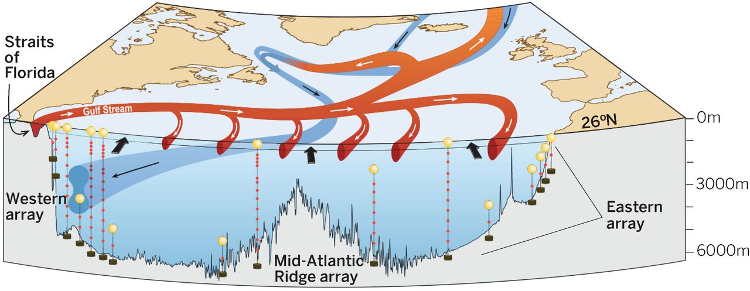
Cross-section of the North Atlantic showing surface water flow of the AMOC and Gulf Stream/subtropical gyre, and the deep water AMOC return flow. Image credit: RAPID project
The above figure shows a cross-section of the Atlantic at 26ºN, the middle of the subtropical gyre and the site of the RAPID instrument array, which measures temperature, salinity and current velocities from the near surface to the sea floor. The graphic shows the Gulf Stream role as part of the subtropical gyre and the AMOC circulation.
The strength of the AMOC circulation depends upon the water’s density in the deep water formation regions. If the density diminishes too much, deep water formation stops, and so does the conveyor. Over a long time, the ongoing process of turbulent mixing lowers the density in the deep ocean to the point where the deep water formation process begins again.
The power of the AMOC is significant. The RAPID array and other instruments yield an estimate of the average volume transport of the AMOC as 17 million cubic meters per second. The heat energy transported by the AMOC is estimated as 1.2 PetaWatts (PW) or 1.2 quadrillion watts.
Why is the AMOC so important?
The deep AMOC, with help from the Gulf Stream surface current, transports the vast majority of its heat into the northern Atlantic region, as shown by the temperature difference between the northward flow and the very cold, deep southward flow.
The climate impact of the AMOC arises from its contribution of 1.2 PW to the northern North Atlantic (north of 24ºN latitude), sufficient to warm this part of the Atlantic about 5 C above the same latitude in the North Pacific. The AMOC globe view earlier suggests that the warm surface currents push back the sea ice margin in the northern Nordic Sea, allowing the sun to further warm the exposed ocean and then the atmosphere above. In fact, the figure below shows this to be the case for the major deep water formation areas around the globe, which exhibit surface air temperatures much warmer than the latitudinal average.
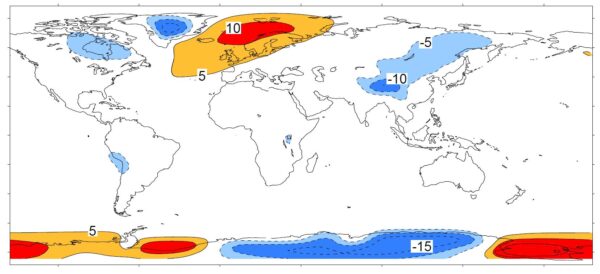
Deviation of surface air temperature from the average for a given latitude (ºC) Image credit: Rahmstorf and Ganopolski
Experiments with modern climate models show the AMOC’s impact on climate. If the model “shuts down” the North Atlantic deep water formation by flooding the upper ocean with freshwater, temperatures over the Nordic Seas and land in northwestern Europe cool dramatically. While various models differ in the details of the climate impact of the AMOC, they agree that it warms the northern latitudes and moderates the south (by exporting heat northward).
A weakening, or worse a shutdown, of deep water formation in the AMOC would impact surface climate, sea level, and marine ecosystems around the world. The Intergovernmental Panel on Climate Change (IPCC) has an AMOC collapse as one of the low probability/high impact risks associated with global warming.
While the AMOC has a positive impact on our climate, the relationship between climate and ocean circulation is a two-way street. As we will see in Part 2 of this post, climate change appears to be slowing down the AMOC, with potentially dangerous consequences.
Part 2 will cover:
- the AMOC slowdown already underway
- how climate change is affecting the AMOC
- the potential collapse of the AMOC
- the global impact of an AMOC collapse
Stay tuned!

